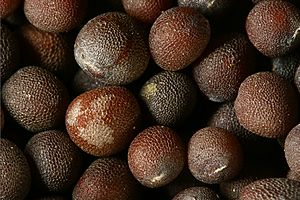Brassica nigra facts for kids
Black mustard (scientific name: Brassica nigra) is a plant that grows every year. People grow it mainly for its tiny seeds, which are a popular spice used in cooking around the world.
This plant originally comes from warm, tropical parts of North Africa, as well as cooler, temperate areas in Europe and some parts of Asia.
Contents
All About Black Mustard
Black mustard plants can grow quite tall, sometimes reaching up to 8 feet (2.4 meters) high! They have bright yellow flowers that grow in clusters. After the flowers, small seed pods form. These pods contain the tiny, dark brown or black seeds that give the plant its name.
Where Black Mustard Grows
Black mustard is found naturally in many different places. It grows well in areas with warm summers. You can find it in:
- Tropical regions of North Africa
- Temperate parts of Europe
- Various regions across Asia
It has been grown for thousands of years in these areas. This shows how important it has been to different cultures for a very long time.
What Black Mustard Is Used For
The seeds of the black mustard plant are very important. They are used in many ways, especially in the kitchen.
As a Spice
Black mustard seeds have a strong, spicy flavor. When you crush them, they release a pungent taste. This makes them a great addition to many dishes.
- They are often used whole in Indian cooking.
- They can be ground into a powder for mustard paste.
- They add a kick to pickles, curries, and sauces.
The seeds are also used to make mustard oil. This oil is popular in some parts of the world for cooking.
Other Uses
Besides being a spice, black mustard has been used for other purposes.
- Historically, some cultures used it as a traditional medicinal plant.
- The leaves of the plant can also be eaten as a leafy green vegetable. They have a slightly bitter taste.
Black mustard is a versatile plant. It continues to be an important crop for its seeds and other uses around the world.
Images for kids
-
Black mustard plants in Saarbrücken.
See also
 In Spanish: Brassica nigra para niños
In Spanish: Brassica nigra para niños






